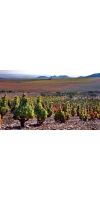Wine from Palacios Remondo

Alvaro Palacios has spent decades pioneering a new order of fine wine across Spain. He has created some of the country’s most iconic wines by championing terroir and native grapes whose potential had been long overlooked and untapped.
Palacios Remondo is his family’s Rioja estate, tucked in the far eastern corner of the Oriental district. The story in this rugged, high-altitude scrubland is about Garnacha—the territory’s traditional variety and also one of Alvaro’s biggest passions. By focusing on Garnacha-driven wines that are expressive of and authentic to this stunning side of Rioja, Alvaro is continuing to reshape the future of Spanish fine wine.
Palacios Remondo was founded in 1947 by the Palacios family in the heart of Rioja, Spain. But the family were no strangers to winemaking—in fact, they’d been producing wine in the region since the late 1800s and had built for themselves a distinguished reputation. But the ’80s brought about changes, and the family decided it was time to focus exclusively on their own, estate-grown wines.
In 2000, fourth-generation Alvaro Palacios took the helm and under his skilled stewardship, the estate has lowered yields, returned to traditional vineyard practices, and focused on organic viticulture. Today, the family remains more committed than ever to crafting beautiful wines that reflect the unique terroir of Rioja’s stunning east.
Rioja Oriental is blessed with a warm, dry Mediterranean-influenced climate (unlike Rioja’s west, where the climate is more continental). The soils comprise alluvial deposits of volcanic rock, quartz, and sandstone, interspersed with carbonate and clay-ferrous colluvial materials including lime and sand.
Rioja Oriental is often described as flatter than the region’s west but make no mistake—there is significant elevation here. Palacios Remondo’s estate vineyards are planted in the foothills of Mount Yerga, at altitudes of 500-650 meters (1,640-2,133 feet) above sea level. The area was first settled and planted by Cistercian monks, which gives the land a “mystic” quality—a key component in what drives Álvaro’s focus on a place.
Some call him a “rebel” or an “iconoclast,” thanks to his maverick approach in breathing new life and prestige into underappreciated regions. He’s also known for his warmth and humility. But at his core, Alvaro Palacios is simply trying to express the unique beauty of Spain’s varied terroir and grapes—and his instincts for scouting out vineyards with sky-high quality potential are unrivaled.
Alvaro was born in 1964—one of nine children. Inspired by his family’s winemaking roots, he left home to attend Bordeaux University where he studied oenology. During a brief stint working for the Moueix family, Alvaro developed a deep appreciation for what he calls “wine beyond the senses.” His objective thereafter became looking for vineyards in places with mystical origins and old vines. After helping to put Priorat (and later, Bierzo) on the fine wine map, Alvaro turned his eyes to his family’s estate. He was convinced that Rioja Oriental was far better suited for Garnacha, the region’s historical variety, than it was for the more commercially viable Tempranillo. Judging from the cascade of critical acclaim and international renown of Palacios Remondo’s Garnacha-based wines, Alvaro’s vision for the future of his family’s estate is coming to fruition.
No products found
- back
Selected Options
Wineries
Categories
Pricing
Countries
Regions
Grape Types
Wineries
Organic/Free Shipping
Silver Oak Alexander Valley Cabernet Sauvignon is made from 95.2% Cabernet Sauvignon, 2.5% Cabernet Franc, 1.9% Merlot, 0.4% Petit Verdot
The Silver Oak Alexander Valley Cabernet Sauvignon 2019 has notes of red cherry, raspberry, blackberry, iris, vanilla and clove. Ruby in color, this elegant wine has great acidity and lift on the mid-palate. Black currant and warm baking spices linger with a deep and fruity finish. It will provide drinking pleasure through 2047 given proper cellaring.
Review:
Silver Oak's 2020 releases of Napa and Alexander Valley Cabernets are downright impressive. Tasted four years after the fires, in September of 2024 at the Alexander Valley winery, neither wine showed any sign of the hardened tannic structure or overwrought fruit often associated with the vintage. Instead, these wines remain true to Silver Oak’s signature style, with blackcurrant, fig, and plum fruits layered with white pepper, sweet cedar, and coriander spice. Medium-bodied, with sculpted tannins that persist through the lengthy finish, the Alexander Valley Cabernet in particular retains all the hallmarks of a balanced, inviting, and vibrant Silver Oak red.
-Decanter 94 Points
Truly gorgeous, fruity, velvety and enjoyable for a full-bodied cabernet. It is rich in blueberries, cherry cream, black cherries and raspberries on the palate, with very smooth, layered tannins and a soothing mouthfeel. So easy to drink now, but it will age well, too.
-James Suckling 94 Points
The Prisoner Wine Co. Blindfold Chardonnay is made from 100 percent Chardonnay.
Blindfold Chardonnay is gorgeously balanced and a true triumph. Fragrant with notes of lime zest, yuzu, jasmine, and a slight minerality, Bright on the palate with juicy green citrus, lychee, green apple and toasted hazelnut. You’ll find both freshness and soft texture from its time in oak. The finish is long and indulgent–let yourself sink into this luxurious pour.
All of the fruit was hand-picked and whole cluster pressed. Barrel fermentation took place in 100% French oak barrels, and 23% New barrels that were selected by forest or grain tightness to frame our fruit profile, bring texture, and soften acidity. Lots were tasted every other week while we stirred the lees to precisely soften the mouthfeel and achieve optimal balance. With fermentation, and subsequent elevage taking place over 11 months we have achieved this goal.
Chardonnay grapes were harvested as flavors of lime zest and green apple started to develop and before acid started to ripen away. Picking decisions were made based on acidity rather than sugar level (Brix). We want to showcase the vineyard sites and growing region in perfect balance.




